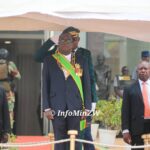
By Conrad Mwanawashe
President Emmerson Mnangagwa’s 2025 State of the Nation Address (SONA) served as both a progress report and a forward-looking policy blueprint, laying out a vision for a modern, inclusive, and climate-resilient Zimbabwe. The address anchored the nation’s economic trajectory on agricultural revival, industrial value addition, technological modernisation, and sustainable development.
Agriculture as the Engine of Recovery
Projecting 6.6% economic growth in 2025, the President reaffirmed agriculture as the foundation of Zimbabwe’s recovery. Record maize, wheat and tobacco yields, he said, reflected the success of the Agriculture, Food Systems and Rural Transformation Strategy and the Pfumvudza/Intwasa Programme, which have “empowered over three million households.”
“Going into the future, the trend in macro-economic stability is expected to become the status quo in our country,” said President Mnangagwa.
The administration’s plan to expand irrigation from 151,000 hectares in 2019 to 496,000 hectares is central to shielding production from droughts and erratic rainfall. Through the Rural Development 8.0 initiative, thousands of boreholes are being drilled and rehabilitated to improve access to water for both consumption and production.
Equally transformative is the accelerated issuance of bankable title deeds for A1 and A2 farmers, aimed at unlocking private agricultural finance. A stronger, self-financing farming sector, Mnangagwa said, would reduce food imports, boost exports, and stabilize the broader economy.
Watch: Stroke of Genius – a skit on title deeds
Industrial Growth Through Agricultural Linkages
The SONA linked primary production to industrial transformation. Manufacturing now contributes 15.3% to GDP, supported by growth in steel, cement, dairy, and textile value chains.
The President emphasized value addition and beneficiation — ensuring raw materials are processed locally to drive job creation and GDP expansion. The commissioning of new industrial plants and “energy parks” across provinces reflects this shift toward domestic production.
“In response to climate change, my government has adopted the National Climate Change Adaptation Plan. The Carbon Trading Framework and Registry, outlined in Statutory Instrument 48 of 2025, is set to unlock climate fi nance and promote mitigation efforts across sectors,” the President said.
Supporting this, legislative reforms such as the Mines and Minerals Amendment Bill and the Zimbabwe Industrial Reconstruction and Growth Plan aim to create a transparent and investor-friendly industrial environment.
The Digital Shift: Technology as a Growth Catalyst
Technology featured prominently in Mnangagwa’s address. The launch of the Zimbabwe National Artificial Intelligence Strategy, alongside the construction of 14 AI-driven Grain Marketing Board silos and the Zimbabwe Integrated Transport Information Management System, signals a decisive move toward digital governance and smart infrastructure.
Automation and data analytics, the President argued, will enhance efficiency, reduce waste, and improve competitiveness. Meanwhile, initiatives like the Digital Ambassadors Programme and upgraded vocational training centres are preparing young Zimbabweans for a digitized economy.
Inclusive and Sustainable Growth
In line with his guiding philosophy of leaving “no one and no place behind,” Mnangagwa highlighted social protection and empowerment measures. The expansion of the Food Deficit Mitigation Programme and harmonised Social Cash Transfers seeks to cushion vulnerable communities.
The National Youth Empowerment Strategy (2026–2030) and gender parity legislation aim to integrate youth and women into the economy. Environmentally, the National Climate Change Adaptation Plan and Carbon Trading Framework are positioned to attract global climate finance and drive green growth.
Governance and Legislation: The Foundation of Delivery
Mnangagwa expressed frustration with Parliament over what he called an “unacceptable backlog of Bills.” He urged lawmakers to fast-track crucial legislation — including the Disaster Risk Management Bill, Tourism Amendment Bill, and amendments to commerce and industry acts — to support his Vision 2030 agenda.
Timely passage of these Bills, he said, is vital for ensuring that policy ambitions translate into tangible outcomes and institutional efficiency.
Challenges on the Road to Vision 2030
While the SONA outlined a cohesive national strategy, implementation remains the key test.
- Execution Capacity: Large-scale irrigation, road, and energy projects require sustained capital and technical management.
- Financing: Mobilising private investment and global climate funds is crucial to sustaining the development drive.
- Governance Integrity: Transparent delivery of empowerment and welfare programmes will determine public trust.
- Comprehensive Resilience: Strengthening preparedness for floods and cyclones, beyond drought mitigation, remains essential.
Turning Vision into Reality
Mnangagwa’s 2025 SONA stands as one of his administration’s most integrated policy statements — blending climate-smart agriculture, industrial growth, and technological innovation into a unified national agenda.
